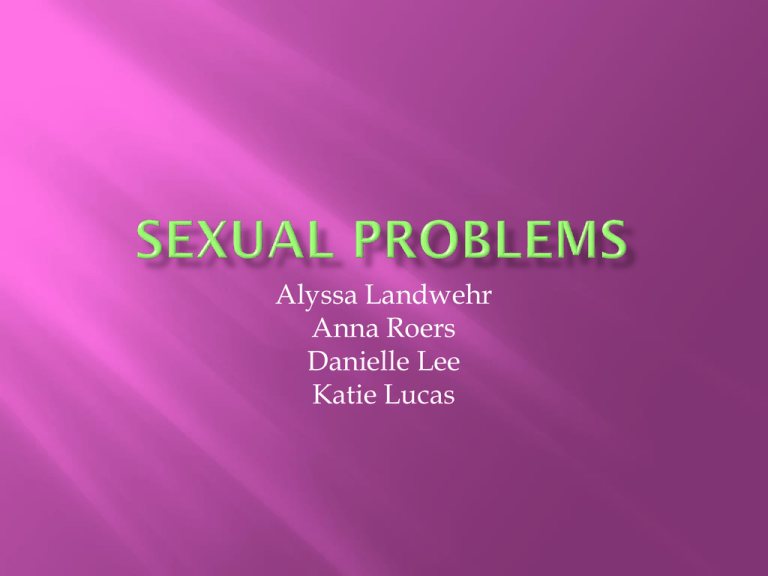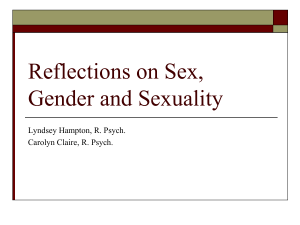
Alyssa Landwehr
Anna Roers
Danielle Lee
Katie Lucas
Sexual problems in children do not represent a
medical/psychological syndrome or a specific
diagnosable disorder, but rather a set of behaviors
that fall well outside acceptable societal limits.
Behaviors involving sexual body parts (i.e.,
genitals, anus, buttocks, or breasts), sexual
thoughts, sexual innuendos, and sexual behaviors
that are developmentally inappropriate or
potentially harmful to themselves or others.
Positive correlation between frequency of child
physical abuse and unrestricted sexual
behavior and variety of sexual fantasies.
Positive correlation between frequency of child
emotional abuse and variety of sexual
fantasies, unrestricted sexual attitudes, and
negative sexual satisfaction and body image
Negative correlation between child neglect and
sexual satisfaction.
Negative correlation between child sexual
abuse and sexual drive.
Positive correlation between child sexual abuse
in females and experience with intercourse,
variety of sexual experience, range of sexual
fantasies, liberal sexual attitudes, frequency of
intercourse and masturbation, and likelihood
of engaging in unrestricted sexual behaviors.
No relation found between child sexual abuse
in males and sexuality variables.
Can affect people of any age, gender, or
culture.
Strong links between early sexual abuse and
sexual problems later in life in females.
Links between early emotional or physical
abuse and neglect with later sexual problems in
both males and females.
Varies depending on:
Sexual problem person suffers from – if any
Gender
Age
When and if a person receives treatment
Some sexual problems seen in adults related to
early abuse could be sexual aversion, anxiety or
avoidance, decrease in sexual desire or sexual
self-esteem, inhibited sexual arousal or orgasm,
vaginismus, and negative attitudes toward
sexual relationships in general.
Normal childhood sexual play and exploration
VS
Child abuse related sexual problems
Sexual thoughts and images that are disturbing
Unusual interest in or avoidance of all things of a
sexual nature
Seductiveness
Statements that their bodies are dirty or damaged, or
fear that there is something wrong with them in the
genital area
Inappropriate sexual behaviors or sexual compulsivity
Describes or imitates sexual behavior
‘Flirts’ with strangers
Forces or pressures children into sexual acts
Kisses with open mouth
Sexual behavior not appropriate for age
Shows sex parts to children (other than siblings)
Starts “rude” conversations, tells jokes about sex
Touches or puts mouth on other persons’ sex parts
Tries to involve others in sexual behavior
Masturbates at home, school or in public in view of
others
Inserts object into anus or vagina
Shows sex parts to adults other than caregivers
Touches or puts mouth on animal’s sex parts
Being mindful of cultural views of children’s
behavior
The main treatments for sexual problems are:
Sex Therapy(PLLISIT Model)
Psychotherapy
Group Therapy
Surgery
This is a common model used in sex therapy.
PLISSIT Model was developed in 1974 by Jack
Annon.
There are four phases of therapy, each getting
more intense as you progress.
Permission
Limited
Information
Specific
Suggestions
Intensive
Therapy
This is the first phase of treatment.
The topic of sexuality is brought up making it
ok for the client to talk about sex
Most clients need permission to talk about their
sexual concerns because they are embarrassed
or ashamed about what has happened to them.
This is the second level of treatment, which
most clients will benefit from.
You address specific sexual concerns with your
client and attempt to correct any
misinformation they might have.
At this level the therapists main goal is to
educate their client in whatever areas they are
having difficulties.
This is the third level of treatment, and fewer
clients require this level of treatment, and
fewer therapists are qualified to provide it.
In this stage of treatment the therapist will
make a profile of the clients sexual history.
They must 1)define the problem then 2)
develop a treatment plan.
You focus on the reasons for the problem and
specific ways to overcome them.
This is the fourth and final level of treatment.
This has the least amount of clients, and
requires special training as a sex therapist.
This step is used when the previous 3 have
failed to resolve the sexual problem.
The therapist completes a full history of the
client, and then provides specialized treatment
for them.
Psychotherapy can help woman identify
problems in their life that may be expressed as
sexual problems.
The therapist usually focuses on resetting the
woman’s attitude towards sex.
The main goal is to get rid of old negative
attitudes about sex, and establish new attitudes
that increase sexual responses.
This is similar to a support group, where
people can come and talk about their problems
together.
Many gain good insight from others about their
problems, and practical solutions they can try.
Many clients can gain confidence from
knowing they are not the only one.
Some therapists may suggest couples therapy
for their clients as well.
Surgery is only used in specific cases where
internal physical problems may impede sex.
Some of these problems may include cysts,
tumors, or growths.
Recognition
Assessment
Intervention
Referral
When child abuse is suspected it should be
immediately reported to a social worker or the
police.
Professionals and concerned citizens can call
statewide hotlines, local child protective services,
or law enforcement agencies to share their
concerns.
Many States identify specific professionals as
mandated reporters; these often include social
workers, medical and mental health professionals,
teachers, and childcare providers.
Healthcare Professional: A doctor or nurse would be
able to see the physical signs of abuse in the child and
note unusual genital appearance associated with sexual
abuse (tearing, bruising, etc).
Educator: A teacher would see the changes in behavior
of a sexually abused child. The child may be acting
inappropriate with peers, start to keep to themselves,
or suddenly start to perform poorly in school. The
teacher would look at all of these things to assess what
could be going on with the child.
Social Worker: A social worker would look at the
child’s behaviors and interactions with others. They
would interview the child and assess the information
given to them.
An adult with sexual problems as a result from
sexual abuse may be assessed by a therapist or
a doctor. The person would have to disclose the
problems they are having physically or
emotionally with that professional in order to
help them get a better understanding of their
situation.
A professional who recognizes signs of abuse
or sexual problems with a child with concerns
of abuse should contact a social worker or the
police.
Social Worker: A social worker would
interview the child to obtain as much
information about the child and the suspected
abuse as the child is willing and able to disclose
with that person.
An adult with sexual problems may be ordered
medications to help with their problem to aid
in sexual activities or to help with anxiety
associated with sexual activities.
The child may be referred to therapy
An adult may be referred to counseling to help
them discuss their feelings on the situation
Joey, was sexually abused starting when he
was four years old up until he was eight years
old. His uncle would take him into a room and
make him undress, molest him, masturbate
while looking at Joey naked, and force Joey to
kiss his genitals. Joey has been seeing a
therapist for the past year. Joey has been
showing his genitals to strangers and
classmates, masturbating in public (in school
and at home in front of company), and has
been pressuring his male friends to undress
and touch his genitals.
Kim is a twenty-five year old waitress at Perkins. She
has scheduled an appointment with a therapist. She
states that she has had an “inhibited ability to
experience sexual arousal,” and she “dissociates during
intercourse” and feels very “anxious” during
intercourse ever since she became sexually active at age
twenty-three. The therapist suspects that Kim was
abused at a child, and after several more sessions Kim
discloses that her father sexually abused her from age
six to age twelve. He would sneak into her room at
night and force her to perform oral sex and intercourse.
Kim also shared that ever since she was abused she has
felt “dirty” and “damaged.”
Meston, C., Heiman, J., & Trapnell, P. (1999,
November). The Relation Between Early Abuse
and Adult Sexuality [Electronic version].
Journal of Sex Research, 36(4), 385-395.
http://arhp.power-pointgenerator.com/supplemental/PLISSIT%20Mo
del.pdf
http://www.emedicinehealth.com/female_sex
ual_problems/page7_em.htm
http://www2.huberlin.de/sexology/ECE5/plissit_model.html
Ayaz, S., & Kubilay, G. (2009, January). Effectiveness of
the PLISSIT model for solving the sexual problems of
patients with stoma. Journal of Clinical Nursing, 18(1),
89-98. Retrieved February 4, 2009, doi:10.1111/j.13652702.2008.02282.x
Sweeney, M.T. (2008). Predictors of problematic sexual
behavior among children with complex maltreatment
histories. CHILDMALTREATMENT, 13(2), 182-198.
Retrieved January 22, 2009, from Cambridge Science
Abstracts database.
Simon, V.A., Fering, C. (2008). Sexual anxiety and
eroticism predict the development of sexual problems
in youth with a history of sexual abuse. CHILD
MALTREATMENT, 13(2), 167-181. Retrieved January
22, 2009, from Cambridge Science Abstracts database.









